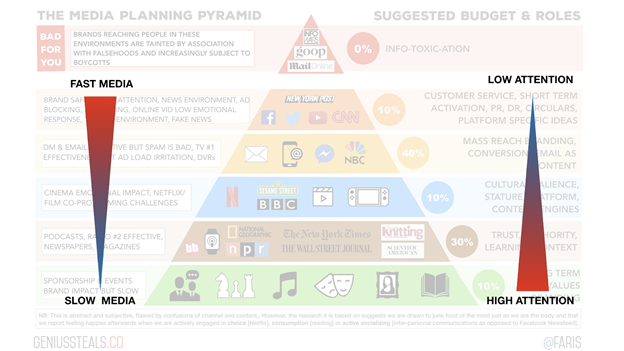Attention matters, argues Faris Yakob, but using it to its full potential is a case of balancing fast and slow media to work across both high and low attention environments.
How fast are you reading this? A meta-analysis of 190 studies suggests the average adult reading speed in English is 238 words per minute for non-fiction (it’s slightly higher for fiction). Whether you are reading this and how rapidly is a function of a number of elements.
The fact that you are reading it at all suggests it is probably relevant to your interests and therefore you probably work in or around advertising. How much attention you focus on it is dependent on the interplay of how much the headline suggests the topic is of particular interest to you, what your pre-existing associations are with the publication and me as the author, and how it is written, displayed and the broader context of consumption.
At the Spark ’21 online conference I spoke at recently, Lumen Research presented some new data from their analysis of how much attention ads on magazine websites receive. According to their tests, “ads on mags are slightly more likely to be noticed at all, and significantly more likely to be looked at for longer, than equivalent ads on comparable publisher or social sites.”
Their research indicates this is a function of time spent consuming the content. In a logical cascade, magazines are made of content that people are choosing to consume, so they take their time over it rather than scrolling past rapidly, which gives the advertising more time to get noticed and then consumed.
Scroll speed is inversely correlated with the attention capture effects of advertising. More attention on the content means more attention on the ads, which has greater commercial effect. This relationship has been demonstrated across other media, with Nielsen showing that the higher the engagement with programming, the higher the ad recall. Online, there is a natural attention curve across sites, with ads on content sites people are there to read so they get more attention, whereas ads on functional sites (like eBay) people are there to do something so ads get less attention.
These findings are in accordance with robust older advertising research. The ARF project How Advertising Works looked at context effects and suggests that a significant part of advertising impact is ultimately driven by attention transfer. Its analysis concluded that there is “strong evidence that more attention to/involvement with the content, platform, device or media brand is likely to improve ad performance”.
The more ads surrounding your ad, the more clutter, the less attention ads tend to acquire. Further, the more the content is liked, the more ads a consumer will watch, according to research from Hulu/Leflein Associates. Beyond attention transfer, there are also priming effects created by congruency. If the advertising is relevant to the topics in the content, it performs better.
What about creative advertising itself capturing attention? This is of course also an important aspect. Because attention can be stimulus driven as well as transferred from context, the transfer effect just makes attention capture more likely.
Before Lumen worked out how to use the webcam in your laptop or phone to do detailed eye-tracking studies, large bespoke studies were done to understand how attention capture and transfer work in print advertising. In Attention Capture and Transfer in Advertising: Brand, Pictorial, and Text-Size Effects, researchers analyzed 1363 print advertisements using infrared eye-tracking with more than 3600 consumers.
The findings make clear that there are ‘unique superiority effects’ to the different elements of a print ad. The image is the best at capturing attention, regardless of its size, whereas the text captures attention in proportion to its size. That means making the picture bigger doesn’t increase attention to the ad but increasing the font size does. Interestingly, the brand element transfers attention to the other two more than the ad transfers attention to the brand element. So if someone spots the brand, it tends to attract more attention to the advertisement.
An associated finding helps put a cliché argument in advertising to rest. Industry dogma suggests there is a persistent tension, that clients want to make the logo bigger whereas creatives would rather render it as discreetly as possible to seduce the reader into the advertisement, without signaling that it is selling too aggressively. The research shows that increasing the size of the brand element has no negative effect on attention capture. Rather than arguing about the size of the logo, we should campaign for larger headlines if we want to capture more attention.
All of this research, new and historic, has the comforting quality of making logical sense. People look at ads more in environments they enjoy and consume slowly, for longer amounts of time, which has a positive commercial impact. However, it’s not as simple as simply planning for slow media. As with any element of communication strategy, it is about balancing the objectives with the messaging and the context.
Low attention processing has an impact. Fast media like billboards and digital display can keep the brand in mind and leave implicit memories that nudge consumers towards purchase. More attention works better, but other considerations such as cost and efficiency come into play when creating a balanced plan. Additionally, media that is consumed more rapidly may also be faster to get into market, which makes it more suitable for shorter term objectives and urgent needs. Magazines have long leads, and sponsorships can take years to agree and deploy, but they also tend to work more slowly, build reach more slowly, and have stronger brand building effects. My media planning pyramid reflects that, highlighting how faster media tends towards low attention and slow media tends towards high attention capture:

The key is knowing how much attention a brand requires based on its current context and campaign objectives, how much it can afford to buy, and then using an appropriate creative strategy that plays to the media’s strengths.
Much modern academic thinking on attention stems from Daniel Kahneman, who published “Attention and Effort” in 1974. Equally, his magnum opus, Thinking Fast and Slow, popularized the idea of System 1 – automatic, fast, driven by instinct and memory – and System 2 – deliberate, slow – thinking. This is of course a conceptual device, both are always involved to some degree, but using it as such a device can be helpful.
Robert Heath pointed out that most consumer decisions are done without much thinking, we often call them low involvement categories. Indeed, that’s how we make most decisions. As Kahneman says, “Thinking is to humans as swimming is to cats; they can do it but they’d prefer not to.” Those brands can certainly find excellent uses for fast media and its limited attention. Reach may be more important than active attention at certain times. Brands in higher involvement categories, or that are in a different stage or different market share position, may seek out slower media opportunities.
Brands will need a combination of both, leveraging the particular strengths of different media to invest in their brands whilst activating sales. This piece probably took you about four or five minutes to read, significantly more attention than consumers give ads. Are you convinced?
This article first appeared in www.warc.com

